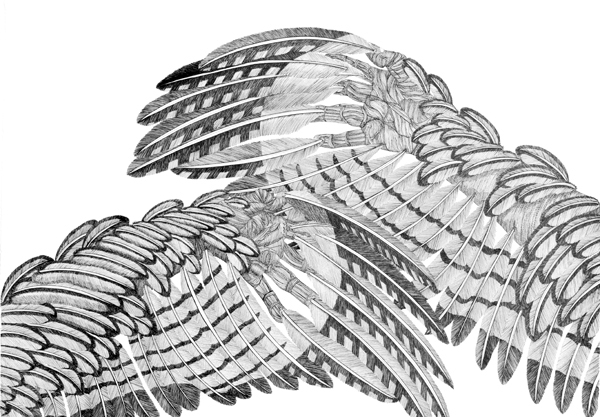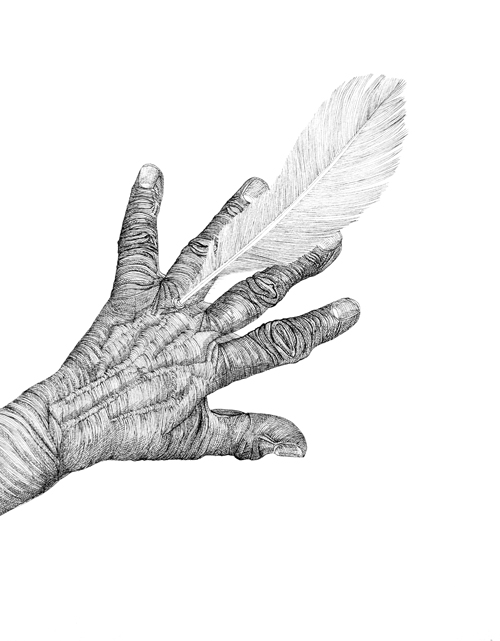CALLY TRENCH
Writings about
Metamorphosis
by Mary Yacoob, Annie Rapstoff, and Guy Tarrant
|
Cally Trench's Metamorphosis drawings
In Cally Trench's ink drawings, Metamorphosis, hyper-cellular details extend a touching counterpoint to surrealist humour. Some drawings evoke performative gestures in outlandish guises. Others speak of fantastical transformations or ritualistic ceremonies. Veins and cracks in the skin are intimately rendered. In drawings such as Metamorphosis (Kite), the human body almost disappears. Fingers are virtually fully transformed into wings, poised in front of the body, and ready to stretch out into flight. Mary Yacoob, July 2022 |
|
Other than human
Cally Trench's Metamorphosis drawings are a series of life-size works of hands and feet in states of 'becoming other than human', of transformation, as feathers emerge from fingers, arms, toes and wrists. The work defies the accustomed order of things: neither heavenly and free as we imagine birds to be, or in human body form as we know it to be. The possibility of new identities, and the freedom to become something other than oneself, is intriguing, but the idea of becoming bird and losing human-ness is disturbing. I am reminded of anatomical drawings, and they are in fact carefully observed images of Cally's own body. I imagine the journey the artist went through to creatively stretch the limits of her human form. As a viewer I am drawn to looking at the details in my hands, seeing my own ageing process, a looseness in my skin, protruding veins. I envision the possibility of feathers piercing through the pores of my own flesh. Moulting is the process by which birds dispose of old damaged feathers to make way for new ones, called pinfeathers, which are short and stubby when they appear. They emerge through the skin, causing the bird irritation and itching. These drawings remind me of that process of renewal. The Metamorphosis drawings sit frozen, as if etched into time, a snapshot of what it might be like to be forever changed. They are betwixt and between, defying the notion of birds in flight or humans as grounded beings, but also curiosities, made into object, transgressive and resisting categorisation. Perhaps if I were living through this transformation in the Victorian period, I would be put into freak show. I am reminded of Angela Carter's Nights at the Circus (1984), in which Sophie Fevvers supposedly hatches from an egg and grows the wings of a swan. She is part-human part-bird and destined to work as a living statue, dressed as cupid, entertaining men.There is a performative element to Metamorphosis, a pride in visibility, drawing the viewer in and reminding us we are vulnerable to change. The termination of the body is shocking, beautiful and abrupt. I am made aware of my own anxiety regarding the possible demise of humanity as we know it. Gilles Deleuze and Felix Guattari discuss the process of becoming animal, which occurs through what they describe as 'contagion'. They describe multiplicities that span across multiple worlds: plant, animal, and human.★ Cally Trench's Metamorphosis interrogates the human body as static, and opens spaces for transpecies, otherkins and interconnections with animals. In a time of climate change, flood, famine and war, it seems right that we question our superiority in the world, look at our flaws and see ourselves as vulnerable. Like the dodo, maybe we too have had our day, just one species among many. Annie Rapstoff, July 2022 ★ Deleuze, Gilles and Félix Guattari, 'Becoming Animal'. In Linda Kalof and Amy Fitzgerald (eds.), The Animals Reader: The Essential Classic and Contemporary Writings, 2007, pages 37-50, Oxford UK |
|
I see seven drawings
I see seven drawings of an artist's hands; they are dark, they are detailed, they all sit on large spaces of white. They are direct. They are in your face and smother your gaze. These hands I notice have feathers, poking - there is a prickly feeling as they seem to purvey an uneasy presence. I am enticed though by the lush illustrative techniques of the artist, the undulating linework, the subtidal tonal application, the life-size quality; I feel a connection to my own hands and to my wider body. In an empathetic way I feel quite literally 'drawn in'. This is testament to the artist Cally Trench, an artist whom I have noted over the years will happily engage in presenting work which will allure the viewer then gradually hitch up with unsettling, cumbersome content and subject matter. The unsettlement here is quietly awkward. I see hands reaching out at dissimilar angles. They do not grasp at anything in particular and have sprouted feathers at their fingertips. This surreal limpness forces me to grapple now. I scrabble to attach history and meaning, Greek, Roman, religious, fairy-tale? I don't really know. The hands have an open gesture though, which seems to signal story. The collective title of these works 'metamorphosis' can inform. So, you go directly to the feathers with notions of flight and magnificence. But these bird feathers aren't particularly that magnificent; they seem quite common in breed, their form looks more appendage than jet-streamed function. Like most of Cally's work there is a hint of everydayness often woven within. I look again. Now I see texture and now I see time. The hands are timeworn, not very old but definitely aged. I see veins and wrinkles of the middling years. I read this clearly as I myself am in my late fifties and my hands have been cruelly revenged by time; firstly through many years of manual labour and secondly as a sufferer of severe eczema. In conversation with Cally, she explained that our hands are always there directly in front of us and we are constantly forced to look at them; they are the clearest exposed reminder of ourselves, for even your face is only ever seen in muted reflection. And so, I am feeling life change. I am feeling shift and I am experiencing the touch of physical deterioration here. It's funny because I wasn't really wanting to feel these things today or indeed perhaps on any day. When you look at complex contemporary artworks, engagement can be tough and it is all too easy to move on; however, wait for a while, hold on to those difficult moments. There is often enough surrounding structure to sustain a hold and enable an uneasy deep dive. I enjoyed this work because it provides an array of diverse interpretations. Art needs work that sets a challenging benchmark. Rest assured that there are still artists such Cally Trench doggedly lurking to make sure that you duly walk across this line. Guy Tarrant, August 2022 |
|
These writings were first published in a Guide to Exploring inside the box: Recent works by Tineke Bruijnzeels and Cally Trench, an exhibition at Cornerstone Arts Centre, Didcot, September-November 2022. Copies are available to buy (price £2) from the artists. |




